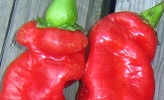Hot
Peppers
Pepper Aji Amarillo (Capsicum baccatum var. pendulum)
Old peruvian strain grown in the Andes for centuries for its pungent peppers. Green peppers turn to orange when completely ripe. Sharp fruity flavor and quite hot. Very good in salsas with lime. Can be used green, ripe or dried. The dried peppers (right picture) turn reddish brown and have an interesting smoky flavor. Remove veins for less heat. Large, tall plans. Use warmth to promote faster germination. Tender perennial, tolerant to light frosts. 100 days.
Packet of 15 seeds: $2,99
Pepper Aji Confusion New for 2025
Capsicum baccatum with pods of variable and intriguing shapes. Each plant produces fruits of different shapes – and even within the same plant, there is some variability, although to a lesser degree. The only consistency is that they are all creamy white in color. In fact, the latter barely change color when fully ripe (they then become a little more yellowish). Large plants of 1 meter with drooping stems. To achieve a more beautiful effect and a mix of shapes, you can group several plants together. Be careful, peppers are quite hot
See New for 2025
 Pepper
Aji Cristal (C. baccatum)
Pepper
Aji Cristal (C. baccatum)
Chilean pepper with semi-translucent, waxy skin. Very hot and spicy, with a lemon touch. Peppers start pale green, then turn yellow-cream and finally scarlet red. Pick young for best flavor (when pale yellow). Good for making salsa. Productive plants. Fruits are about 9 cm long, with thin walls. From Curico, Chile. 90-100 days.
Packet of 10 seeds: $2,49

Pepper Aji
Dulce
(Capsicum chinense)
A very unique pepper with exceptional taste and just a bit of
heat. Sweet flavor with spicy, tropical aroma. In other words, a
habanero without the painful bite! Good for latin american rice
dishes (arroz con ...), beans, soups, etc. Top shaped, 1-inch
fruits, some more flattened. Good ornamental. From Venezuela.
Popular in Puerto Rico. Also known as Rocotillo, Cachucha.
Germination: 60-65%. 90-110 days.
Packet of 20 seeds: $2,99

Pepper Aji Limo (Aji Limo Rojo)
Peruvian variety traditionally used with fish (ceviche, tiradito) and beef (lomo saltado), and also to prepare ajis (Peruvian hot sauces). The bright red fruits are slightly variable in shape, more or less elongated and wrinkled, and with a waxy skin. They are between 5 and 9 cm long. This pepper is quite hot, with taste reminiscent of habanero. Leaves an stems are slightly pubescent. About 95 days.
Packet of 15 seeds: $2,99
Though it is called "aji" and it looks like a C. baccatum, this variety is indeed a C. chinense. Not to be confused with Aji Limon (below), which is a C. baccatum with yellow pods. There seems to be different colors of Aji Limo out there; the one we offer is the red subcultivar (rojo).C. baccatum.
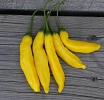


Pepper Aji Limon
Gorgeous lemon-colored peppers revealing a hot and fruity taste. Used in peruvian dishes to spice up fish, ceviche and sea foods. Peppers are bright yellow, thin-walled, slightly wrinkled and about 9 cm long. It is a Capsicum baccatum, which takes a while to produce ripe peppers. Pods start to turn yellow in September. Large plant with sprawling stems. Peru. 100-120 days.
Packet of 10 seeds: $2,99
Aka "Lemon Drop", "Hot Lemon" and "Kellu Uchu". Do not mistake for "Aji Limo"(above), another peruvian variety.


Pepper Aji Panca (Capsicum baccatum)
Wel- known pepper in Peru for making salsa, stews, escabeche and to flavor fish. Often sold dried or in a paste. Peppers turn brownish red when mature, and burgundy brown when dried. Flavor gets better when dried (smoky). Medium heat. Popular pepper with the Aji Amarillo in Peru. Like some other C. baccatum, it takes a while though to get ripe peppers (September-October). At least 100 days.
Packet of 10 seeds: $2,99

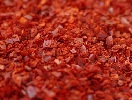
Pepper Aleppo
Middle Eastern variety used dried to season various dishes. Peppers are 10 to 13 cm long, pleated, turning burgundy red at maturity. Once dehydrated, they take on a fruity arroma reminiscent of raisins. Aleppo pepper powder is sometimes mixed with sumac or zaatar (a blend of ground thyme, sumac and toasted sesame seeds). Popular in Armenia, Turkey, Lebanon and Syria. Medium heat. Also called "Halaby" and "Pul Biber". 80-90 days
Packet of 15 seeds: $2,99

Pepper Alma Paprika
White tomato peppers gradually blushing to red. Beautiful. Slightly hot, but milder when seeds and veins are removed. Said to be one of the best for making homemade paprika, though its has thick walls and may not be easy top dry. Also good fresh. Round, flattened fruits, 5-6 cm by 3,5 cm. Thick flesh: 8 mm. Small, compact plants. 70-80 days.
Packet of 10 seeds: $2,99
 Pepper
Anaheim
(New
Mexican, Numex)
Pepper
Anaheim
(New
Mexican, Numex) Long tapered peppers used frequently in southwest cuisine (Tex-Mex). Also know as Numex. Very popular for grilling. Can also be used dried for ristras or stuffed for making chili rellenos. 80 days. Anaheim peppers grown here in Quebec did not have much heat (barely noticeable).
Packet of 20 seeds: $2,49
Dark green, heart-shaped peppers with glossy skin. 15 cm long.
Only slightly hot. Popular mexican pepper used for chiles rellenos (stuffed
peppers) and moles.
Called Poblano fresh
and Ancho once dried.
Excellent for stuffing or cooking on the grill. Tall plants (75
cm). Often served stuffed with refried beans or meat and covered
with melted cheese. 90-95 days.
Packet of 10 seeds: $2,49
Larger Cayenne type that can reach up to 25 cm long (10 "). They can be picked green or later when they turn red. Can be eaten fresh or dried. Slightly wrinkled and twisted. 25 cm long by 2,5 to 4 cm wide. Click thumbnails for details. Heat goes from medium to quite hot. Remove seeds and veins for less heat. Tall plants, close to 1 m tall. Around 85 days (green), 100+ days (red).
Packet of 20 seeds: $2,49



Pepper Biquinho
Beautiful brazilian pepper with distinctive shape. Nice
aromatic flavor; sweet, fruity and peppery. Very little heat.
Beautiful as garnish in dishes. Also great as a novelty pickled
pepper. If you like Aji Dulce and Trinidad peppers, you will
love this one. Small fruits, about 3 cm long, growing in large
numbers. Decent production in southern Quebec. Peppers start
turning red towards the end of August.Warm conditions or water
stress may increase hotness a bit. Pepper is named after its
unique shape, reminiscent of a "small beak". Nice ornamental in
the garden or in pots. Click thumbnails for details. Capsicum
chinense. Brazil. Around 100 days.
Packet of 15 seeds: $3,49
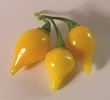
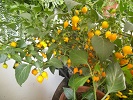

Pepper Biquinho Yellow (Biquinho
Amarela)
Wonderful yellow strain of the popular brazilian biquinho. Click
thumbnails for details. Beautiful as garnish in dishes. Also
great as pickled peppers. Like the red strain, this one has very
little heat (depending though on the growing conditions), like
perhaps the Aji Dulce, with a sweet, fruity and peppery flavor
typical of C. chinense. This variety is both a nice
ornamental and a tasty treat. Grows relatively well even in the
north (southern Quebec); peppers start turning yellow towards
the end of August. Small peppers (2,5 cm) with uniquely shaped
"beaks" ("biquinho" meaning "small beak" in portuguese) . Around
100 days. Hard to find outside Brazil. Capsicum chinense.
Packet of 10 seeds: $3,99
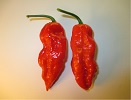
Pepper Bhut Jolokia (Ghost
Pepper)
This pepper from India definitely belongs to the "super hots",
reaching 1 million on the Scoville scale! In other
words, it is up to 10 times hotter than a habanero (!). World
record for hottest pepper (2007). Wrinkled peppers, about 10 cm
long, with very thin walls. Turn scarlet red in September.
Obviously, one needs to be careful handling these peppers. Very
tasty when used appropriately (tiny amounts). Also called "Ghost
Pepper". Used in India to repel elephants. A cross between two
different species of Capsicum: C. frutescens and C.
chinense. 100-120 days.
Warning: Germination is good but slower (up to 3
weeks). Use warmth (28-30 C).
Packet of 10 seeds: $2,99

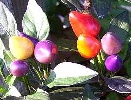
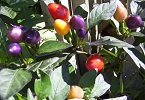
Pepper Bolivian Rainbow
Very nice onrnamental pepper variety. Pods turn purple, yellow,
orange and then red. Can be grown in a container. About 40 cm.
Very, very hot. 80 days.
Pack of 10 seeds: $2,99
 Pepper Bulgarian Carrot
(Shipka)
Pepper Bulgarian Carrot
(Shipka) Bright orange, shiny elongated pods reminiscent of
carrots. Ripen from green, to yellow, and finally orange.
About 8 cm long. Fruity/citrusy aroma followed by quite a
bite. Crunchy. Great for roasting, pickling, salsas,
chutneys, hot pepper jam. Heat level goes from relatively
moderate (Jalapeno) to medium hot (like Cayenne). Nice
ornamental too, when covered with ripe peppers. Medium size,
40 to 60 cm tall. Heirloom from Eastern Europe
(Bulgaria/Hungary). Good yields. Early. 70-80 days.
Packet of 15 seeds: $2,49

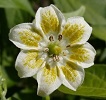
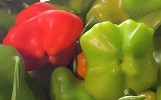
Pepper Cambuci (Aji
Orchid)
Brazilian variety producing beautiful, pendant flower-shaped
pods. Click thumbnails for details. Both ornamental and tasty.
At the green stage, these peppers taste already pretty good,
with a slightly sweet, aromatic flavor. Actually, most Cambuci
peppers sold in brazilian markets are at the green stage (see
links to picture below*). When they turn red, they get even more
flavorful. It is important to note that most ripe fruits will
develop some heat. But, contrary to Bishop's Crown, they are
much less hot, and the heat is located solely in the center,
around the seeds. The "flaps" of the peppers have zero heat.
Large, sprawling plants, 1,50 m high and 1 m across. Definitely
needs staking. Lobed fruits, 5-6 cm by 4-5 cm, walls: 5 mm;
usually 3 to 4 lobes. Late (100 days), but grows relatively well
even in the north (southern Quebec). Start early. Capsicum
baccatum.
Packet of 10 seeds: $3,99
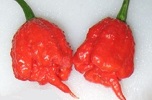
Pepper Carolina Reaper
The Carolina Reaper was the hottest pepper in the world from 2013 to 2023, with a scorching heat reaching up to 2,2 million SHU (average:1,6 million). In other words, it could be up to 20 times hotter than a habanero. So please use with caution. The 3 to 4-cm warthy pods often dipslay a "stinger". A selection of Ed Currie in South Carolina. About 120 days.
Packet of 10 seeds: $3,49.
 Pepper Cascabel
Pepper Cascabel Mexican strain with tomato like, small rounded
fruits (3-5cm). When dried they turn brown and produce an
unusual rattlesnake-like sound when shaken (thus their name).
Used mainly dried. Medium heat. 90 days.
Packet of 15
seeds: $2,49
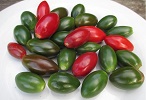
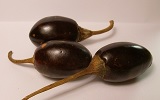
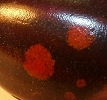
Pepper Catarina
Mexican variety with oblong peppers,
named after the ladybug for their typical shape (and some
dried peppers actually show a spotted skin). Medium heat,
generally hotter that Jalepeno. Used
mainly dried, like a Cascabel; they have then a
smoky, earthy flavor with some berry undertones. Variable
size and shape (3 to 6 cm long), from oval to oblong (some
plants yield more elongated fruits). Red
peppers on plant look a bit like big olives. When
dried, some peppers get a spotted skin, thus their name,
meaning "lady bug". Plants are about 40-60 cm high. C.
annuum. 85 days..
Germination takes 2 weeks (with bottom heat) and rate is
around 65%.
Packet of 15 seeds: $2,99
Long, narrow red fruits
about 10 cm long that are used mainly to make Cayenne pepper
(once dried and grounded). They can also be used fresh.
Popular in Caribbean or Thai cuisine. Very hot!
Packet of 20 seeds:
$1,99



Pepper Charapita
A rare variety from the Amazon, bearing tiny, orange fruits. Medium heat and nice fruity undertones. Bushy, compact plants, around 40 cm high. Both ornamental and tasty. Very small fruits (1 cm).Peppers start to turn orange here in September. 100-120 days. Amazon, Peru.
Packet of 10 seeds: $2,99
 Pepper Cherry Hot
(Cherry Bomb, Cerise Fort, Satan Kiss, Bacio di
Satana)
Pepper Cherry Hot
(Cherry Bomb, Cerise Fort, Satan Kiss, Bacio di
Satana)
Golfball-size red fruits on
a beautiful compact, ornamental plant. Good fresh, dried or
for pickled chiles. Sweet and very, very hot! Also known as
"Cherry Bomb". 85 days.
Packet of 20 seeds: $1,99
 Pepper
Chi-Chien
Pepper
Chi-Chien
Chinese variety with clumps of small red peppers
growing upwards. Very hot. Thin walls, easy to dry. 6 to 7,5
cm long. Ripe peppers turn to dark red. Plants are bout 45
to 60 cm high. Ornamental value. Popular in chinese cuisine.
80 days.
Packet of 15 seeds: $2,49


Pepper Chilhuacle Black (Chilhuacle Negro) New for 2025
Dark green pods turning dark chocolate brown when fully ripe and used mainly dried to make mole negro. Spicy and fruity flavor, with notes reminiscent of raisins, cocoa, molasses and tobacco. Medium-sized peppers (8 cm), more or less triangular in shape, with a leather-like skin.. Easy to dry. Very good as pepper flakes or paprika. This variety originating from Oaxaca produces quite well in Quebec and this is most likely due to the work of Adaptive Seeds, who selected it for the climate of the American northwest. 95 days.
See New for 2025
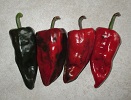
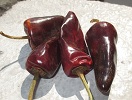
Pepper Chilhuacle Red (Chilhuacle Rojo)
Ancient strain from Oaxaca used traditionally to prepare mole coloradito, or mole rojo (dark red chili paste). Shares some obvious traits with the Poblano, with its long, thick stem and its dark green color at the immature stage. Medium heat, variable shape (from short-conical to elongated), 8 to 12 cm long. Thin walls. Dries easily. Starts dark green, then turns red. Like the other 2 chilhuacles (yellow and black), this one is only grown sporadically in some areas of Oaxaca. Name means "old chile" in nahuatl. Grows well in southern Quebec. Around 90-100 days.
Warning: this variety is not completely stable and will sometimes yield yellow-orange pods (Chilhuacle amarillo).
Packet of 10 seeds: $3,49
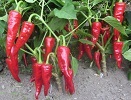
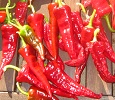
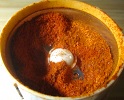
Pepper Chimayo
Early producer of great drying peppers, with low to medium heat. Perfect for ristras, dried pepper flakes or tasty ground pepper powder (paprika). Can also bu used fresh, on the grill (Tex-Mex, NuMex) or for making salsas. Moderate heat, at the level -or slightly below- that of the Jalapeno. Probably one of the earliest hot pepper around; starts blooming sometimes even before transplanting outside. The Chimayo gave good yields even during our mediocre season in 2017, and most peppers had time to fully ripen. Compact, well-branched plants, about 40 cm high. Elongated pods, 8 to 15 cm long, bright red, with some variation in shape. Easy to dry. One plant can yield over 20 peppers. Early, about 70 days.
Packet of 10 seeds: $2,99
Heirloom from Chimayo, small mountain town at 2000 m elevation, north of Santa Fe, New Mexico. Grown for over 300 years. Mostly grown and sold in Chimayo. In its native terroir (Sunny, dry high elevation), the Chimayo pepper has a complex, smokey aroma. The taste might be different when grown in different conditions. The ones grown in Quebec were still pretty good and gave a sweet paprika with a mild heat.
 Pepper Chocolate
Cherry
Pepper Chocolate
Cherry
Nice round chocolate fruits with reddish tinge. Hot. Uncommon.
Fruit size ia about 4 cm.
Packet of 10 seeds: $2,99
 Pepper Conquistador
Pepper ConquistadorAnaheim type known for its absolute lack of heat (or very little). Great for grilling, stuffing, and chili rellenos. Thick walls. Nice flavor. Plants are about 70 cm high. 75 days. Treated seeds (thiram).
Packet of 25 seeds: $1,99
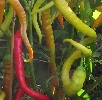
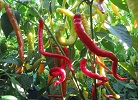
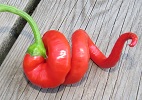
Pepper Corbaci
Turkish variety with very long, thin, twisted peppers. Can reach up to 30 cm long. May look like a hot pepper at first glance, but it has no heat at all. Sweet type. For freah eating or drying (ristras, flakes, sweet paprika). Ripens from pale green to yellow, orange and then red. Beautiful plants in late summer, with al the different shades. Some pods grow like a pig's tail or a corksrew. Tall plants (1 m). Productive.
Packet of 10 seeds: $2,99

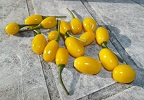

Pepper Cumari do Para
Brazilian variety packing a lot of flavor into tiny yellow peppers: intensely sweet, fruity and hot at the same time! Small, lemon yellow peppers, around 2 cm long. Oval to oblong. Late (100 days or more). First fruits start ripening in September in southern Quebec. Start early and/or grow in pots (overwinter for a larger crop on the 2nd year). From the brazilian state of Para (amazonian basin).
Packet of 10 seeds: $3,99
 Pepper de Arbol (Chile del
Arbol)
Pepper de Arbol (Chile del
Arbol)
Small Mexican peppers that are quite hot (8 on the Scoville scale). Small, about 7 cm long. Thin flesh, so they are quite easy to dry. Can then be grounded like Cayenne pepper. Tall plants, about 1,20 m high. 90 days.
Packet of 15 seeds: $2,49
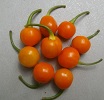
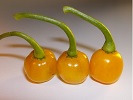

Pepper de Bode (Bodinha, Bode Amarela, Bode Laranja, Pimenta-de-bode)
Brazilian variety with nice, rounded pods and long, curved stems. Reminds of orange cherries. Around 1,5 cm. Click thumbnails for details. These peppers are medium hot, with a typical habanero fruity taste. Used in Brazil to flavor meats, rice, beans, and for pickling. Fruits start ripening in September in southern Quebec. Late variety: start early*. Hard-to-find pepper outside Brazil. ** From the states of Goias and Minas Gerais. Late, 100 days or more.
Packet of 15 seeds: $2,99
Link: pickled Bode peppers, with pictures (brazilian page in portuguese)
* Like other late peppers, growing in pots and overwintering is a good idea for northern gradeners. Cut back plant in fall and keep inside during winter. Do not water too much until spring.
**This is the orange strain of Bode (Bode Amarela or Laranja).

 Pepper Espelette
Pepper Espelette
Basque variety from Northern Spain renowned all around the world
for its rich flavor. Well balanced heat, somewhere between
Paprika and Cayenne. Slightly curved red fruits, 10 cm by 3 cm.
Medium thickness walls (3-4 mm). Sold in european markets on
ristras or as ground pepper. Grows well in Quebec. Delicious,
especially in powdered form. About 80 days. Limited stock
(smaller packets).
Packet of 15 seeds: $3,49
 Pepper Fatalii
(Capsicum chinense)
Pepper Fatalii
(Capsicum chinense) Habanero type with long, pointed, slightly wrinkled yellow fruits. Very, very hot. Fruits are about 6 to 8 cm long, with a citrusy-fuity flavor followed by a burning sensation. Use carefully, and in small amounts. Remove veins for less heat. Plant height: 60 cm. From Africa. 100 days.
Packet of 10 seeds: $2,99
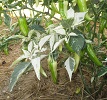

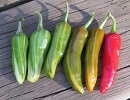
Pepper Fish
Ornamental type with variegated foliage, stems and pods. Click thumbnails for details. Stripped peppers, about 8 cm long, turning orange and then red. Medium hot. Used in the Cheasapeake Bay area to spice up fish and sea food. Please note that the white coloration on the leaves does not appear in the first stages of growth. Also, this variegation is not homogeneous inside the same plant -and also between plants.* 50-60 cm high. 80 days.
Packet of 10 seeds: $2,99
*Intensity of variegation varies from plant to plant. Goes from intensely variegated (almost albinos) to totally absent (full green), and everything in between. Thus, you must start at least 2-3 plants to insure at least one variegated plant. You can grow them together and select later on only the best one(s).


Pepper Fresno
Jalapeno-style peppers with a slightly more conical shape, thinner walls and an upward growing habit. Versatile, can be used for a number of preparations (salsa, nachos, canning, etc.). The green pods are moderately hot (Jalapeno), but when they turn red, they step it up a few notches. An early variety well adapted for northern gardeners. 75 days.
Packet of 15 seeds: $1,99
 Pepper Guajillo
(Mirasol)
Pepper Guajillo
(Mirasol) Popular mexican cultivar used to season many dishes (stews, soups, tamales, etc.) and prepare moles, salsas and other spicy sauces. Medium heat. This pepper is almost exclusively sold in its dried form. Dark brown/redddish/purplish hue. Can also be used to prepare harissa (tunisian pepper paste). Taste is fruity, herbal and slightly smoky. Very nice, complex flavor, with hints of prunes, berries, back tea, herbs, etc. Like many other mexican peppers, is known by two names, depending if it's fresh (Mirasol) or dired (Guajillo). Pods in the garden look like giant cayennes or Espelette Peppers. Turn red at maturity. Can also be picked at the green stage for grilling or pickling. It is recommended to use a food dehydrator to dry them. 90 days.
Packet of 15 seeds: $2,49

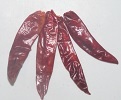
Pepper Guntur Sannam
Variety from India with medium green pods turning red when
mature. 10 to 11 cm long. Very popular in India and mostly
sold in its dried form. Pods harvested in Quebec had a
moderate heat level; most of then did not have time to turn
red before end of season. Fortunately, this pepper is still
pretty decent at the green stage. Late variety (green: 80-90
days, red: 100+ days).
Packet of 20 seeds: $2,49
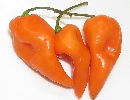 Pepper
Habanada
Pepper
Habanada
A habanero without any heat at all. Nothing, zero, nada. What remains is the great fruity aroma typical of Capsicum chinense. Delicious. Pods are longer that normal habaneros, reaching 10 cm long. Compact, bushy plants. Good production. You can harvest over 20 peppers per plant. Even unripe pods are tasty. About 100 days.
Packet of 10 seeds: $2,99
One of the hottest peppers in the world, 20 to 50 hotter than
Jalapeno! Lantern-shaped, wrinkled dark green fruits turning
orange when ripe. Burning taste with fruity, apricot undertones.
Cut peppers with gloves to prevent burning. Remove veins and
seeds to lessen heat. Popular in the Caribbean. 90-100 days.
Packet of 30 seeds: $1,99
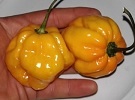


Pepper Habanero Big Sun
A large
habanero, up to 5 cm long. Click
thumbnails for details. Ripens from green
to bright yellow, then turns golden yellow
with some orange hues. Wrinkled pods,
variable in shape, globular to slightly
elongated. Skin is unusually shiny and
almost looks like it's been polished.
Taste is fruity and very, very hot!
Officially, Big Sun is at the same heat
level as a habanero but after tasting it,
I believe it could be twice as hot. Unripe
pods can be pale green or dark green, but
all turn golden at maturity. Similar to Burkina
Yellow. 90 days.
Packet
of 15 seeds: $2,99
Pepper Habanero Caribbean Red
Red habanero type, even hotter than the regular habanero (1,2 to 2 times hotter). Bright red fruits, some smooth, some more wrinkled, round to elongated in shape, 2 to 4 cm long. Said to be sweeter and tasting a bit like strawberry (?). From Yucatan, grown in the Caribbean. Plants about 75 cm high. Around 90-110 days.
Packet of 10 seeds: $2,49
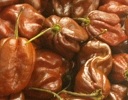
Pepper Habanero Chocolate (Chocolate Habanero)
Dark chocolate brown peppers, often twice as hot as orange habaneros. In other words, about 100 times hotter than a Jalapeno ( ! ). Sweet, fruity flavor typical of habaneros, but with an earthy, smoky twist. Once dried and/or smoked, these peppers are said to be even tastier. Fresh, dried or for salsa. Obviously, please use with caution and wear gloves when cutting them. Slightly larger than the typical habanero, about 5 cm long. Can be grown in pots. C. chinense. Around 100 days.
Packet of 10 seeds: $2,99

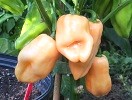
Pepper Habanero Peach (Peach Habanero)
Gorgeous peppers in a nice shade of pale peach. Click thumbnails for details. 6-7 cm long, slightly wrinkled. Fruity flavor and very hot. Productive. 90 days.
Packet of 15 seeds: $2,99

Pepper Habanero Small White
Small white habenero peppers growing in tight clusters. Ornamental and edible. Super hot. Oblong pepper, 2 cm long. Around 100 days.
Packet of 15 seeds: $2,99

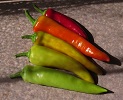
Pepper Hot Hungarian Wax
Early variety, well adapted to short seasons, producing light green peppers turning yellow, orange and then red. Mainly used for pickling. Can be seen in big glass jars at delis and restaurants in Montreal, pickled whole or into rings of different colors (yellow, orange and red). Can also be used fresh, roasted, fried or stuffed. Elongated, tapered pods, around 14 cm long, that can be harvested at any stage. Medium hot. Good yields, even in cooler conditions. Recommended for short season areas. Hot Banana, Hungarian Yellow Wax. 75 days.
Packet of 15 seeds: $1,99
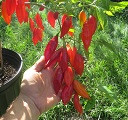
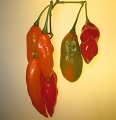

Pepper Hot Paper Lantern
A very nice habanero strain bearing abundant clusters of peppers changing from lime green to orange, scarlet and then deep red. Better yields and earlier than regular habaneros. Pods are elongated with a shiny, waxy skin. Look and feel like plastic peppers! Click thumbnails for details..And yes, they are pretty hot (similar to habaneros). Can be used fresh or dried. Slightly wrinkled pods, around 10 cm long. Tall, vigorous plants (60-100 cm), with slightly different foliage than regular C. chinense. Productive. Unique. Hot Paper Lantern Habanero. 70 days (lime green), 90 days (red). Limited quantity.
Packet of 8 seeds: $2,99
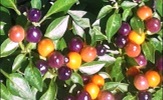
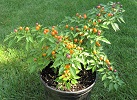
Pepper Hot Pops
Beautiful
ornamental covered with tiny, marble-like pods turning from
purple to orange. 0,8 to 1 cm. Small plants, well-branched,
15 to 20 cm tall, and 30 to 35 cm wide. Can be grown in
small pots (20 cm). Peppers hold well on the stems and end
up all turning to orange by end of August. Can be eaten
(yes, they are hot). Seems to be determinate, as the plants
stop making new flowers towards end of season. Hot Pops
Purple.
Packet of 15 seeds: $2,99
 Pepper Hungarian
Black
Pepper Hungarian
BlackLooks like a Purple Jalapeno, but slightly larger and wider. Also, the heat will disapear when it's completely ripe. Nice pruple flowers. Pods darken as they mature. 5-6 cm. Around 70 days (purple).
Packet of 15 seeds: $2,49
 Pepper Jalapeno
(Capsicum annuum)
Pepper Jalapeno
(Capsicum annuum)
The archetype of the mexican peppers and one of the most well
known in the world. Named after the city of Xalapa. Stocky and
tapered dark green peppers. Great flavor with a nice bite. Used
extensively in every kind of salsa and mexican meals. They are
also sold as pickled peppers. Each plant yields about 15
peppers. Can be frozen. Remove veins and seeds for less heat. 75
days.
Packet of 25 seeds: 1,99$
A milder jalapeno strain. About 3 to 5 times less hot
(1000-1500 SU). Excellent for fresh use: sliced or diced and
then added to nachos or tacos. The frozen peppers are easy to
grate. Dark green peppers (6.25 by 3.25 cm) with medium-thick
walls. Resistant to several diseases (TMV, TEV, PEMV, PYV). Bred
at Texas A&M. 65-70 days.
Packet of 15 seeds: $2,49


Pepper Jamaican Hot Yellow (Yellow
Scoth Bonnet)
A yellow Scotch bonnet variety with scorching
heat. Thin walls, heavily wrinkled, and taking a variety of
shapes, some of which really like a scoth bonnet. About 5 cm
by 3,5 cm. Compact plants. C. chinense. Late, starts
ripening in September around here. 100-120 days.
Packet of 10 seeds: $2,99

Pepper
Japones
Popular
in Japan and China (provinces of Hunan and Sichuan), but also in
Latin America and the Caribbean Islands. Used mainly in its
dried form to spice up different meals, such as sauteed
vegetables, meats, etc,, and to make hot sauces. Pods grow
upward in clusters of 5 to 6. They are slightly larger than a
Thai pepper: 7 cm long. "Medium" heat (6 to 8 times that of a
Jalapeno). Plants are about 60 to 80 cm tall. Also known as Hontaka,
Santaka et Yatsufusa. 80 days.
Packet of 20 seeds: $2,49

Pepper Joe E. Parker
NuMex type with thick, crunchy flesh. For chili
rellenos (stuffed peppers), southwest-style grilling,
or any other NuMex recipe. Long pods, 15 to 18 cm long. Tasty,
low heat peppers. Usually eaten when
still green. Similar to NuMex Big Jim below, but shorter,
stouter pods, an a bit earlier. 70 days (green), 95 days
(red).
Packet of 20 seed: $1,99
 Pepper
Joe's
Long
Pepper
Joe's
Long Cayenne
type with extra long, thin pods reaching up to 30 cm
long. Bright red fruits with medium heat. Dries
fairly well, good for flakes or ground hot pepper.
Heat level increses with maturity of pods.. Tall
plants, 1 m. Very productive. Originally from Italy,
then brought to North America. About 90 dats (red).
Probably the longest hot pepper out there.
Packet of 10 seeds: $2,99
 Pepper Medusa
Pepper Medusa
Dwarf plants barely reaching 15-20
cm high. One of the smallest variety with Nosegay. Tightly
packed flowers and peppers on a well-branched bushy plant.
Peppers matures from cream to yellow, orange and red. Although
it
is listed in Hot Peppers, these have no heat at all. Child
safe.
Packet of 25 seeds: $2,49

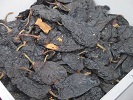
Pepper
Mulato
Similar to Poblano (Ancho), but turning brown at
maturity. Used mainly for moles, sauces and stews. Part of
the holy trinity of mole peppers (Ancho-Pasilla-Mulato).
Once dried, it looks indeed like an Ancho but it is darker,
almost black (as opposed to the Ancho, which is more of a
dark, reddish brown). Another difference is the taste,
sweeter, fuller, with hints of cocoa, anise, black cherry
and tobacco. Dark green pods, around 15 cm long, with low to
moderate heat. Can be picked at the greens stage for salsa,
chile rellenos, etc. For drying, choose the mature pods
(brown) and preferably use a food dehydrator. 75-85
days (green), 95-105 days (brown)
Packet of 10 seeds: $2,99
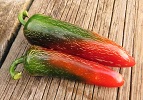
Pepper Nadapeno
A Jalapeno without any heat.
Tastes somewhat like a bell pepper, perhaps with a subtle
difference. For a sweeter flavor, wait until pods turn red.
Large fruits, many over 10 cm. Good yields. 55 days (green), 90
days (red).
Packet of 15 seeds: $2,99


Pepper NuMex Big Jim
NuMex type with very long pods and low heat. For chili
rellenos (stuffed peppers), southwest-style grilling,
or any other NuMex recipe. One plant can produce up to 30 pods,
which can grow over 30 cm long. Supposedly holds the record for
the longest pepper in the Guiness Book of Records (?). Generally
eaten when still green. New Mexico (USA). Around 80 days
(green).
Packet of 20 seeds: $1,99


Pepper NuMex Twilight
Ornamental type with small, 3 cm peppers that
change color from purple, lavender, yellow, orange and red.
Each plant is simultaneously covered with different colored
peppers. Good ornamental. Can be grown in pots. Edible
peppers, but very, very hot! 100-120 days.
Packet of 10 seeds: $2,49


Pepper Padron
Spanish heirloom served traditionally in tapas bars, cooked in olive oil and sprinkled with sea salt. Most of the time, it shows no heat, only a nice green pepper taste and a mild bitterness. But sometimes, you get a real fiery one. These peppers are picked ideally when they are very young, at only 4-5 cm long. If you picked them later, they will become quite hot. Deep green pods, 4 to 10 cm long, thin walls. "Pimiento de Padron". Northwest Spain, Galicia. Early, about 65 days (green).
Packet of 15 seeds: $2,99



Pepper Paprika Boldog
This variety is purported to be the original pepper used for making paprika in Hungary, aka "the real paprika", which is much more flavorful that the commerical one. And yes, after tasting it, it is actually much better, with a complex, rich earthy taste and a bit of heat too. Peppers get a more subtle, fuller taste after drying. Medium thin walls, relatively easy to dry. Moderate heat. Long, tapered pods, deep red, 15 to 20 cm long. Used in Hungary to prepare such dishes as the popular goulash and chicken paprikash. For less heat, remove seeds and veins. 90-110 days.
Packet of 10 seeds: $2,49

 Pepper Pasilla
Pepper Pasilla
Though used sometimes fresh in mexican meals, Pasilla peppers
are mainly used dried and grounded to flavor the moles (thick sauces). Long
and narrow, shiny dark green peppers reaching up to 20 cm long
and then turning brown when ripening. Low heat and rich smoky
flavor with hints of raisins and cocoa. Dried peppers can be
grounded top make a flavorful paprika. Called Chilaca when fresh. Bajio strain resistant to
TMV. 80 days.
Packet of 15 seeds: $2,99



Pepper Peppapeach Stripey New for 2025
Beautiful pale peach pods with red stripes. Each one is unique and displays a different pattern. Click thumbnails for details. Sweet and hot flavor. This variety has smaller plants than most baccatums, reaching about 60-70 cm high. Can be grown in pots. About 90 days.
See New for 2025


Pepper Prik Chi Faa (Prik Chee Faa, Chifa Red)
Thai variety with dark green, slender pods ripening to red. In their country of origin, they are often picked young for sauteed vegetables, or used to spice up pad thais and seafood. They are also dried. The heat level of this pepper varies greatly, but it is generally in the medium range (16 000 SHU). The ones we grew in Quebec turned out to be relatively mild (especially for a thai variety). Heat is said to increase as pods mature. Supposedly, the original Sriracha sauce (not the commercial one) was made with Prik Chi Faa peppers, salt, sugar an garlic, and let to ferment (?). Germination: 70%
Packet of 10 seeds: $2,99
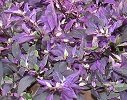
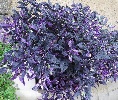
Pepper Purple Flash
Striking purple foliage with some streaks of white and green. Click thumbnails for larger pictures. Compact, 30-40 cm high. Good for pots or borders. Peppers are tiny, 6 to 10 mm in diameter.
Packet of 10 seeds: $2,99
 .
.
Pepper Rocoto Yellow Rocoto Amarillo, Manzano, Locoto, Canario (Capsicum pubescens)
An altogether different species of Capsicum (C. pubescens) with very
unique characteristics. It has hairy leaves, purple flowers and
dark brown seeds. Stems get also rigid (woody). Tolerant to
light frosts (- 5 C), can live up to 15 years and get huge.
Fruits are golden yellow, more or less pear shaped, 6-7 cm long.
Glossy skin. Thick, juicy flesh. Quite hot! Used fresh to make
salsa. From the Andes, grown in high altitudes all over central
and south america. Also known as Manzano
("Apple"-Pepper), Peṛn ("Pear"-Pepper) or Pepper
Tree. 120 days.
Packet of 10 seeds: $2,99
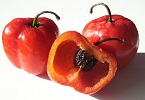

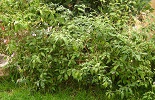
Pepper Rocoto Red
Popular in Peru, especially in the south of the country
(Arequipa), often served stuffed (rocoto relleno). Like the
yellow strain, this pepper shares many unique traits: downy
foliage, purple flowers, black seeds, woody stems, long life (up
to 15 years) and resistance to light frosts. Red strain with
thick-fleshed red pods, 6-7 cm, smooth skin and quite hot. Can
be used fresh for salsas, pickling or rocoto rellenos.
Plants can grow quite large after a few years (see 3rd picture).
Can be trimmed.
Very late, at least 120 days. *
Packet of 8 seeds: $3,49
If you live in frost-free areas, you can let them outisde for winter. They can even withstand light frosts.
 Pepper Sandia
Pepper Sandia
A NuMex/anahiem type with medium heat. Used green
for salsas, chili rellenos, or grilled peppers. Southwest-style
food, Tex-Mex, NuMex. When red, can also be dried and used for
ristras or ground pepper. Heat level increases with maturity of
peppers. Slighty curved, elongated pods, 15 to 18 cm.
Thick walls. Productive plants, 1 m. Selected by the University
of New Mexico. 75 days.
Packet of 15 seeds: $2,49

 Pepper Santa Fe Grande
Pepper Santa Fe Grande
Southwestern strain producing jalapeno-like, pale
yellow fruits. They eventually ripen to orange and then turn
red. 3 cm by 6-8 cm long. Good in salsas, for cooking or
pickling. Medium heat. Very productive, 20 to 50 peppers on
a single plant. Southwest United States. 75-80 days.
Packet of 10 seeds: $2,99
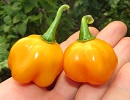
Pepper Scotch Bonnet Orange
A C. chinense type similar to the Habanero, but more flattened and ruffled. Turns from green to yellow and then orange. Sweet and fruity taste. Very hot. Popular in the Caribbean islands. 90 days.
Packet of 15 seeds: $2,99
 Pepper Serrano
Pepper SerranoPopular mexican strain used in salsas, hot sauces, Tex-Mex, nachos, guacamoles, etc. Smaller and thinner than a Jalapeno, 2 to 3 times hotter. From the mountains of Puebla and Hidalgo, Mexico. Mostly used green, so no need to wait for the peppers to ripen before harvesting. Heat levels can vary depending on growing conditions. About 80 days (green).
Packet of 20 seeds: $2,49



Pepper
Shishito
Very productive dwarf japanese variety yielding dozens of
wrinkled hot peppers. Shishito is a japanese frying pepper with
medium heat, also used to flavor tempuras and other meals. Also
known as Sweet Wrinkled Old
Man. Early, ripen quite fast. Very thin walls, easy to
dry. Well branched plants, about 35 cm high.
Packet of 10 seeds: $2,99
 Pepper
Sonora
Pepper
Sonora
A
NuMex/Anaheim type with very little heat. Ideal for
chilis rellenos, Tex-Mex or NuMex cuisine, grilled
peppers, salsas, etc. Versatile. Usually picked
green. Elongated pods, 20 to 25 cm long. Good
yields. 75-80 days.
Packet
of 15 seeds: $2,49

Pepper
Sugar Rush
Peach
New
for 2025
A Capsicum baccatum
selection with long, pale peach-orange
pods. Sweet and tropical taste, but also
quite hot (50,000 to 100,000 Scoville
units). Tall plants of 1 m with long
drooping stems, typical of baccatums. The
10-cm peppers ripen gradually from yellow
to peach-orange. Relatively early for a
baccatum, at 60 days (yellow) and 80 days
(peach). Looks like a paler and earlier
version of the peruvian Aji Amarillo.
See New
for 2025



Pepper Tabasco
Very hot peppers used to make the famous Tabasco sauce. The
plants are covered with 5-cm fruits maturing from white to
yellow, orange and to red. Ornamental value. Tall plants, up to
1,5 m high. From Tabasco state, Mexico. 90 days.
Packet of 10 seeds: $2,49.

Pepper Tepin
(Chiltepin) (Capsicum annuum, v. aviculare)
One of the smallest pepper, at barely 1 cm. Still grows in the
wild in northern Mexico. Natives collect the fruits. They are
used to make a very hot salsa. Can be dried and ground. Bushy
plants. Also called "Gringo Killer" and "Bird Pepper ".
Use warmth to facilitate germination (25 to 35 C).
Packet of 15 seeds: $2,99
 Pepper
Thai
Pepper
Thai
For southeast asian cuisine, soups, noodles, pas thai, curry,
seafood, etc. Looks like "Thai Chili" (see Hot Peppers), but
with smaller pods (4 to 5 cm). 15 to 20 times hotter than
a Jalapeno. Plants are early enough to yield loads of mature
peppers, but they can also be harvested at the green stage (as
is the case for green curry paste). Medium-size plants, about 70
cm tall.
Packet of 15 seeds: $2,49
Small dark green
peppers growing upward on a tall plant. Similar to the small
thai peppers commonly sold in markets. Quite hot. Can be picked
green or red. 100 days. Germination: 70%, but packet now has 30
seeds.
Sold out.


Pepper Thai
Ornamental
New
for 2025
A more compact variety
than the standard thai pepper, with bushy
plants about 30 to 35 cm high. Pods are
also smaller, measuring 2 to 2.5 cm long.
Easy to grow in pots, either alone or in
groups.(...)
See New
for 2025


Pepper Trinidad
(Trinidad Perfume)
Highly fragrant peppers but with only a hint of
heat. Like a tamed habanero: you get all the spicy, fruity
flavor, but without the hellish fury. Golden yellow fruits, 4-5
cm, lantern-shaped. Interesting flavor, similar to Aji Dulce and
Zavory (see below). 90-100 days. Limited stock.
Packet of 10 seeds: $2,99
For a similar variety, but slighly hotter, see "Pepper Zavory",
below.

Pepper Zavory
Back
for 2025
Delicious peppers with a fruity,
tropical aroma simlar to a habanero,
but with just a bit of heat. One
could say that they have just the
perfect balance between flavor and
spiciness. They are indeed very
tasty. Good production of 4-cm
bright red fruits. Just
a tad hotter
than Aji Dulce
or Trinidad
Perfiume. A
very nice variety. 90 days.
Packet of 10 seeds: $3,49


Pepper Zebrange New for 2025
Wonderful orange peppers with red stripes. Very beautiful. Each pod is slightly different (click thumbnails for details). Taste is rather hot. Tall plants reaching 1 m high, with long drooping stems bearing 6 to 9-cm long pods.
See New for 2025






